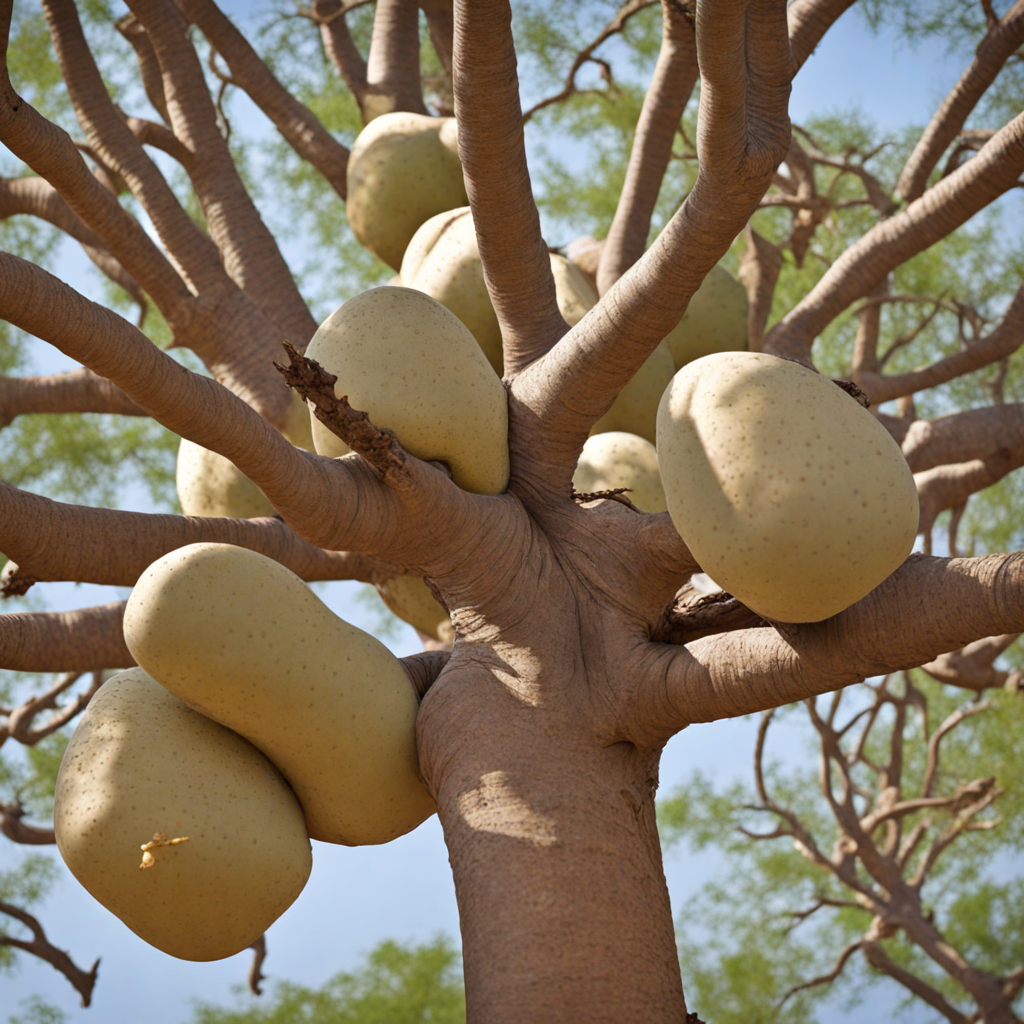Baobab Fruit
Baobab fruit, often referred to as the "superfruit," is native to the African continent, with Sudan being one of its prominent cultivators. This unique fruit grows in the iconic baobab tree, known for its distinctive, broad trunk that can store water and help sustain life in arid climates. The fruit has an oval shape, with a hard outer shell that encases a dry, powdery pulp. When you first encounter baobab fruit, you'll be struck by its rugged exterior, but the real magic lies within, where its tangy, sweet flavor unfolds, reminiscent of a mix between citrus and pear, with hints of vanilla. The taste of baobab is not just delightful but also complex; it has a refreshing tartness that can invigorate the palate, making it a perfect addition to various dishes. The pulp is often consumed in its raw form, but it can also be blended into smoothies, sprinkled over cereals, or used as a natural sweetener in desserts. Its versatility extends to savory dishes as well, where it can provide a unique twist to sauces and marinades. For those looking to explore new flavors, adding baobab to your culinary repertoire can offer an exciting taste adventure. In addition to its delicious flavor, baobab fruit is packed with nutritional benefits, making it an ideal choice for health-conscious food lovers. Rich in vitamin C, antioxidants, and dietary fiber, it supports overall wellness while tantalizing your taste buds. The fruit’s unique combination of taste and health benefits has started to capture the attention of chefs and home cooks alike, bringing a piece of Sudan's culinary heritage to kitchens around the world. Whether you enjoy it in a beverage, as a snack, or incorporated into a dish, baobab fruit offers a delightful experience that speaks to the richness of Sudanese culture.
How It Became This Dish
The Baobab Fruit: A Culinary and Cultural Treasure of Sudan #### Origins of the Baobab Tree The baobab tree, known scientifically as *Adansonia*, has its roots deeply embedded in the African landscape, particularly in regions like Sudan, where it has thrived for centuries. This iconic tree, often referred to as the "Tree of Life," is renowned for its immense trunk, which can store thousands of liters of water, allowing it to survive in arid climates. Among its many species, *Adansonia digitata* is the most recognized and widely used for its fruit, the baobab fruit, or "ثمرة الباوباب" in Arabic. The origins of the baobab tree are shrouded in myth and folklore, with many African cultures attributing it a mystical significance. Local legends often depict the tree as a creation from the gods, embodying the spirit of resilience and sustenance. The baobab has adapted to its environment over millennia, making it a focal point in the ecosystems where it grows, especially in the dry savannas of Sudan. #### Cultural Significance in Sudan In Sudan, the baobab tree is not just a part of the landscape; it holds a critical place in the lives and cultures of its people. The tree serves as a gathering place, a source of shade, and a habitat for various wildlife. Its fruit, known for its distinctive shape—hard and oval with a powdery, white pulp inside—has been an integral part of local diets for generations. The baobab fruit is celebrated for its nutritional value. It is rich in vitamin C, antioxidants, calcium, and dietary fiber, making it a superfood in its own right. Traditionally, the fruit is harvested when ripe, often between June and September, and can be consumed fresh or dried. The pulp can be used to make a refreshing drink, added to porridge, or even utilized in traditional medicine to treat various ailments. In Sudanese culture, the baobab fruit is often associated with communal sharing. Families gather to harvest the fruit together, fostering a sense of community and collaboration. The rituals surrounding the harvesting and preparation of the fruit are steeped in tradition, with knowledge passed down through generations. This communal aspect reinforces the baobab's status as a symbol of life and sustenance. #### Development Through Time The history of the baobab fruit in Sudan can be traced back to ancient times. Archaeological evidence suggests that the baobab tree was present long before recorded history, with its fruit likely being consumed by early inhabitants of the region. Over centuries, as civilizations in Sudan evolved, so did the uses of the baobab fruit. In the pre-Islamic era, the baobab was revered in various indigenous cultures, where it was often seen as a source of nourishment during times of drought and scarcity. As trade routes developed across Sudan and the broader African continent, the value of the baobab fruit began to expand beyond local consumption. It became a trade item, sought after for its unique flavor and health benefits. Merchants would carry the fruit to markets, introducing it to new cultures and communities. With the advent of Islam in the 7th century, the cultural practices surrounding the baobab fruit transformed but did not diminish. The fruit continued to be incorporated into the diets of Sudanese Muslims, who appreciated its nutritional properties and versatility. The baobab tree and its fruit became entwined with agricultural practices and seasonal festivals, marking important times in the agricultural calendar. During the colonial period in the late 19th and early 20th centuries, the baobab fruit faced new challenges. Colonial powers often disregarded indigenous knowledge and practices, which included the sustainable harvesting of baobab fruit. However, local populations continued to rely on the tree for its sustenance, and the baobab remained a symbol of resistance against colonial encroachment. In contemporary times, the baobab fruit has garnered international attention. As global interest in superfoods has surged, the unique properties of the baobab fruit have led to its exportation and incorporation into various culinary practices worldwide. In Sudan, producers have begun to recognize the economic potential of the baobab fruit, leading to initiatives aimed at sustainable harvesting and marketing. This shift has brought renewed interest in traditional harvesting methods, ensuring that this cultural heritage is preserved even as it adapts to modern demands. Today, the baobab fruit is not only a staple in Sudanese diets but also a symbol of cultural pride. It represents the resilience of its people and their deep connection to the land. Culinary innovations have emerged, with chefs experimenting with the fruit in modern dishes, blending traditional flavors with contemporary culinary techniques. Baobab powder is now being used in smoothies, energy bars, and even pastries, highlighting its versatility and appeal. #### Conclusion The history of the baobab fruit in Sudan is a rich tapestry woven from threads of tradition, sustenance, and cultural identity. From its origins as a vital resource for ancient civilizations to its status as a modern superfood, the baobab fruit continues to play a significant role in the lives of the Sudanese people. Its journey through time reflects the resilience of a culture deeply rooted in the land, showcasing the importance of preserving culinary heritage in an ever-evolving world. As the global community becomes increasingly aware of the nutritional benefits and cultural significance of the baobab fruit, it is crucial to recognize and honor the traditions that have sustained it for centuries. By doing so, we not only celebrate the baobab's unique contributions to Sudanese cuisine but also promote the sustainable practices that ensure its future for generations to come. The baobab tree, with its sprawling branches and storied past, remains a powerful symbol of life, community, and the enduring connection between people and the land.
You may like
Discover local flavors from Sudan







